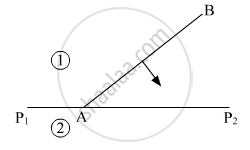Advertisements
Advertisements
प्रश्न
How is a wavefront different from a ray?
उत्तर
- The ray indicates the direction of propagation of the wave while the wavefront is the surface of the constant phase.
- The ray at each point of a wavefront is normal to the wavefront at that point.
APPEARS IN
संबंधित प्रश्न
Using Huygens's construction of secondary wavelets explain how a diffraction pattern is obtained on a screen due to a narrow slit on which a monochromatic beam of light is incident normally.
You have learnt in the text how Huygens’ principle leads to the laws of reflection and refraction. Use the same principle to deduce directly that a point object placed in front of a plane mirror produces a virtual image whose distance from the mirror is equal to the object distance from the mirror.
When the width of the slit is made double the original width, how would this affect the size and intensity of the central diffraction band?
Derive the law of reflection using Huygen’s Wave Theory.
Define the term wavefront. Using Huygen’s wave theory, verify the law of reflection.
Define the term 'wavefront of light'. A plane wavefront AB propagating from a denser medium (1) into a rarer medium (2) is incident of the surface P1P2 separating the two media as shown in fig.
Using Huygen's principle, draw the secondary wavelets and obtain the refracted wavefront in the diagram.

According to Huygens principle, ______.
Huygen's conception of secondary waves ______.
What type of wavefronts are associated with a source infinity?
Using Huygen's wave theory of light, show that the angle of incidence is equal to the angle of reflection. Draw a neat and labelled diagram.
